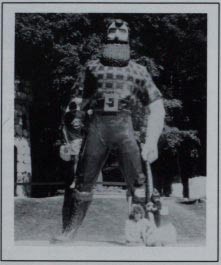Paul Bunyan, who caused earthquakes whenever he dropped his biscuits and whose ax handle was made out of a whole pine tree trunk, was never a real folk hero of the lumbering trade. He was the inspired invention of one William Laughead, advertising agent for the Red River Lumber Company of Minnesota and California from 1914 until 1930.
As a symbol of the development of the lumber industry in America, however, Paul Bunyan is the perfect character. He starts out in Maine as a great big baby, like America itself, and clearcuts a path all the way to Puget Sound. He's resourceful, gigantic, innocent and — flat, insubstantial. When compared to real life folk heroes, he has no soul. Where's the rough edge, the grit of eccentricity, the troubling detail that won't fit, the mystery that lingers on, demanding a story or song? Where's the excitement of the truth arm-wrestling with fiction?
Take George Knox, a 19th century lumberjack hero from Aroostook County, Maine, whose superhuman feats became supernatural powers in the telling. It was said by the men who worked in the watershed of the Meduxneag River that George sold his soul to the devil for 20 years for 20 dollars. With the devil's help he could move logs onto the teamsters' load without even touching them, build a road in a day by himself (when no one was looking, of course), remove huge rocks by chewing on them, and put his hands on money whenever he needed it. To get a drink all he had to do was walk up to a tree, peel back the bark and fill his jug with whiskey.
He could turn fish into deer meat, heap an empty table with fresh fruit and doughnuts, throw his voice, imitate wild animals. Like all good American folk heroes, George Knox was known to put braggarts in their place. When a new man came into the logging camp one winter boasting of his prowess in killing wolves, George filled the woods with their howls, sending the cowardly newcomer skedaddling up a tree, to the satisfaction of everyone around.
The reputation which the real life George enjoyed—and surely he must have enjoyed some of it — had a price attached. The other men were afraid of him and he spent much of his time alone. He had to live like the devil because of their pact, said one lumberjack, and he didn't even have a good suit of clothes. He correctly foretold the hour and day of his own death, saying that when the candle at his window went out, so would he. That was in 1892; he was30 years old. He died of tuberculosis, a tall, slender man with an ordinary, curled mustache whose powers were larger than life.
Arriving in the Minnesota woods at about that time was Otto Walta, also called Otto the Finn, a fairly short, square man (nonetheless reputed to be so large you could get a cold by walking through his shadow) whose phenomenal capacity for work was much celebrated, as was his tender heart (so tender he couldn't bear to squash the bedbugs in his mattress, or make a horse work when it was tired, hitching himself up to the sled instead). He could rip up railroad tracks with his bare hands, bend a three-inch steel bar into the shape of a fishhook to pry up a pine stump, twirl logs over his head like puny matchsticks.
Unlike many other legendary heroes looking for recreation after hours, Otto was not a big fighter. He was, however, a big eater. Once when helping a neighbor drag home a bear he'd just shot, Otto had to pause for a snack. He ate four pounds of raw bear right on the spot, then slung the rest of the carcass over his back and invited his neighbor to ride on top.
Otto's machismo (called sisu in Finnish) made good material for stories and songs. In "The Frozen Logger," he appears at a remote cafe in a winter storm to court a waitress. She sings the song, in which she recognizes him as a logger "and not a common bum/ For no one but a logger/Stirs his coffee with his thumb."
She continues, "My lover was a logger/There's none like him today/If you poured whiskey on it/ He'd eat a bale of hay."
When Otto leaves, he gives her a big kiss, so big he breaks her jaw, and thus she sadly explains, "I could not speak to tell him/He'd forgot his mackinaw." He saunters out into the snow "at 48 below." It drops to 100 below — no problem; but at 1000 degrees below zero. Otto succumbs. Later, when his body is found, it's frozen so solid that "If you believe me sir/They made him into ax blades/ To chop the Douglas fir."
In comparison with these ragged tales of courage, strength and hard work, the Paul Bunyan stories are much too slick. It's the difference between a fabricated dream and a dream told, hooked to the raw truth of our humanity.
(For further reading: Richard Dorson's America in Legend; American Folklore and Legend, edited by Horace Beck; Hear the Wind Blow: American Folk Songs Retold, by Scott Sanders.)


